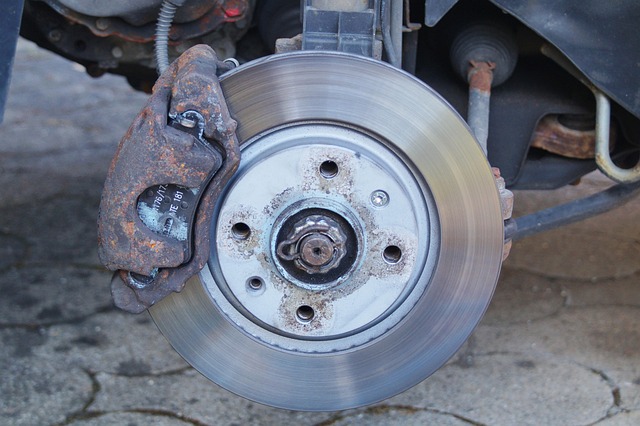ABS technology enhances vehicle safety by monitoring wheel speed during emergency stops. Diagnosing and repairing ABS issues requires removing rust, ensuring component integrity, and selecting compatible brake systems through compatibility checks. Brake problems are identified through visual inspection, electronic scanning, and heat distribution analysis. Repairs involve meticulous removal of faulty components, internal inspection, and decisions between repair or replacement based on cost and condition. Master cylinder repairs are a common, cost-effective solution, ensuring reliable braking performance that meets industry standards.
“Experience seamless braking with expert ABS repairs. This comprehensive guide delves into the intricacies of Anti-lock Braking Systems (ABS), exploring their function, common failure modes, and effective diagnosis techniques. Learn the step-by-step repair process, utilizing specialized tools to ensure precision and safety. Discover how to navigate complex ABS issues, ensuring your vehicle’s braking system operates at peak performance. For a reliable select brake systems solution, trust this expert advice.”
- Understanding ABS Systems: Function and Failure Modes
- Diagnosing Brake Problems: Tools and Techniques
- Repair Process: Step-by-Step Guide to Expert ABS Repairs
Understanding ABS Systems: Function and Failure Modes

ABS (Anti-lock Braking System) systems are sophisticated pieces of technology designed to enhance vehicle safety during emergency stops. These systems monitor and control wheel speed, preventing wheels from locking up and enabling drivers to maintain steering control. Understanding how ABS works is crucial when addressing repairs, especially for professionals providing expert ABS repairs.
ABS malfunctions can occur in various ways, such as sensor failures, hydraulic issues, or electronic defects. For instance, rust on brake components can interfere with the proper functioning of sensors, leading to inaccurate speed readings. Removing rust from these critical parts and ensuring their integrity is a key step in diagnosing and repairing ABS problems. Some repair shops offer universal brake kits for custom cars, which can be useful when replacing worn-out car brake replacement parts online. However, selecting the right brake systems requires meticulous consideration of vehicle compatibility to ensure optimal performance and safety.
Diagnosing Brake Problems: Tools and Techniques

Diagnosing brake problems requires a meticulous approach and an array of specialized tools. Professionals start by inspecting the brakes’ visible components, checking for signs of wear, damage, or leaks. This initial evaluation helps narrow down potential issues to specific areas, such as rotors, calipers, or hydraulic lines.
Advanced diagnostic techniques involve using electronic scanners to monitor brake systems, including selective brake system testing (SBST). This method identifies problems like air in the system, low fluid levels, or faulty sensors. Additionally, removing rust from brake components is crucial for maintaining optimal performance, especially in older vehicles. For high-performance sports cars, where brake cooling solutions are essential, specialized tools measure heat distribution to ensure efficient braking under extreme conditions. Accessing these parts online has never been easier, with a wide range of car brake replacement parts readily available.
Repair Process: Step-by-Step Guide to Expert ABS Repairs

The ABS (Anti-lock Brake System) repair process involves a meticulous, step-by-step approach to ensure optimal brake safety standards and regulations are met. It begins with a thorough inspection to identify the faulty component, which could range from the master cylinder to wheel speed sensors or hydraulic lines. This is crucial as even a minor misalignment can impact vehicle stability during braking. Once the problem area is pinpointed, the next step involves removing the affected part(s). This requires specialized tools and expertise to avoid damaging other systems.
After disassembly, technicians inspect internal components for wear, corrosion, or damage. They may choose between repairing or replacing these parts based on their condition and cost-effectiveness. A popular option for many vehicles is master cylinder repair vs. replacement, where a skilled mechanic can often restore the cylinder to like-new condition, saving costs. All repairs are performed in adherence to top rated brake pads for everyday driving, ensuring that every vehicle leaves the workshop with reliable braking performance and adheres to industry standards.
When it comes to ensuring vehicle safety, expert ABS repairs are indispensable. By understanding the intricate functioning of Anti-Lock Braking Systems and their potential failure modes, along with the latest diagnostic tools and techniques, professionals can effectively navigate the repair process. Following a meticulous step-by-step guide, select brake systems can be restored to optimal performance, enhancing driving safety and reliability. This comprehensive approach to ABS repairs is crucial in addressing complex issues and selecting the best solutions for modern vehicles.
